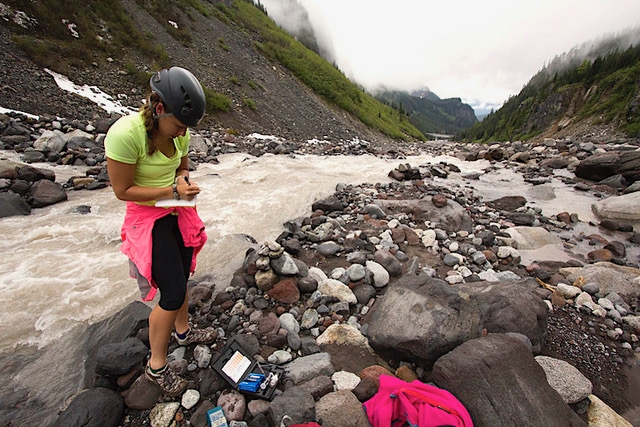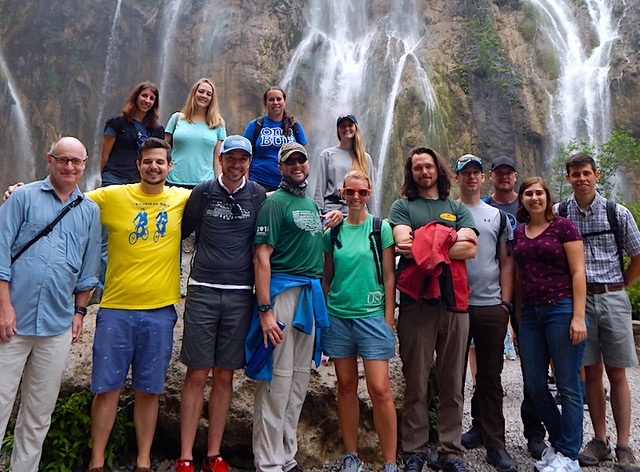Unplugged: Leading Online Students Beyond the Screen

By Kieran J. Lindsey
How many ZOOM meetings does it take to deliver a high-quality online learning experience to graduate students in an environmental sustainability program? Zero.
Online doesn’t mean onscreen
Some assignments don’t even require an electrical outlet, as demonstrated by Dr. Dan Marcucci, a member of the Online Master of Natural Resources (MNR) faculty at Virginia Tech. Each semester, Dan and students in his Sustainability Systems class organize what they call “The Big Sleepout.” This group activity allows members of the class to be together in spirit even though they are apart geographically. They spend a night under the stars, sometimes with family members in tow, to deepen their understanding of a familiar landscape and the concepts they’re learning in the course. While sharing thoughts, images, and sounds from around the globe with fellow students, they’re also building a cohesive, supportive learning community that makes for a richer educational experience.

Wait a minute... camping can be an online course activity? Definitely! Because the Online MNR program was created with adult learners in mind, a field trip doesn’t require reserving a university van, collecting liability waiver signatures, and then setting off together to a single location with a vigilant instructor along to protect students from the great outdoors; as Dr. Jim Egenrieder learned when asked to switch his Watershed Stewardship course from face-to-face to virtual.
Jim was enthusiastic about the move to online, but he wasn’t keen on eliminating class excursions to a local watershed to take and test water samples, identify trees and invasive plants, and map riparian zones. Instead, he decided to make these activities voluntary for the online course. He provides detailed instructions so students can participate from wherever they are, and then watches as those same students transform the course from a singular focus—the Chesapeake Bay Watershed on the northeastern coast of North America—to a collage of diverse watersheds on several continents.
Different by design
I know it may be surprising to find out that something as low-tech as a sleepout, or collecting a sample from a stream, could be part of an online graduate course. Particularly now, when the recent need to move traditional courses to emergency remote delivery has campus-based faculty and students logging in to streaming virtual conference services as if that (a.k.a. pandemic pedagogy) is the only instructional option.
It is true, when online higher ed classes were first offered, nearly two decades ago, early adopters tried to mimic the physical “brick box” classroom experience as closely as possible; in part due to tech limitations, and in part to garner acceptance from peers and legitimacy in the eyes of critics and accreditors. Few online faculty thought to question whether the classic model was truly the gold standard experience everyone should try to replicate.

An interesting thing happened, though, as Internet access, speed, and throughput grew. Virtual instruction began to pivot from imitation to innovation. Once virtual educators, including Online MNR faculty, began to think outside the lecture-centric classroom box, they realized students don’t have to be looking at a screen to learn.
There are many online course design options that prioritize participatory learning over note-taking. Class discussions, for instance, are a common feature of graduate courses. While it might not seem obvious at first glance, online discussions offer some significant advantages. For example, discussions during a 50–75-min face-to-face class can have an oral pop-quiz feel that keeps many students from participating, and conversation is heavily weighted toward opinion. Online discussions, in contrast, may unfold over one to two weeks. Students have more time to reflect before responding to a prompt, and instructors can require online discussion comments to include a citation or other reference link. Moreover, it’s hard to hide in an online course—instructors can see exactly who participated and how, so if a student doesn’t engage it’s as good as not showing up at all.
Spontaneous exchange of ideas
Assigned readings are another opportunity for active learning. Online MNR faculty member Dr. Adam Kalkstein has students in his Climate Change Science course self-organize into “book clubs.” All members of a club read the same title and discuss it in periodic conference calls they schedule on their own throughout the semester. The book clubs report back to the class as a whole in an online discussion forum, and each student also submits an individual book review as a graded assignment.
Group work is a common feature in both educational and work settings. Businesses have embraced globally distributed teams, taking advantage of communication platforms like Slack and Basecamp to manage asynchronous collaboration. These enterprises value workforce-ready professionals who are comfortable in virtual spaces and adept at organizing and leading far-flung team members—skills that graduate students in the Online MNR program learn by participating in assignments like Dr. Desiree DiMauro’s weekly scavenger hunts, in which virtual teams of students in her Biodiversity Policy course work together to find resources and answer questions related to prompts.
Face-to-face with faculty
Last but not least, there’s no rule stating that online students and faculty can’t meet in person from time to time. This might happen informally, when virtual students discover they live near one another, or formally, as when Online MNR students travel to Argentina, India, Cuba, or other locations as part of our core Global Issues in Environmental Sustainability course. These 10-day Global Study trips make it feasible for online students with jobs, families, and other responsibilities to participate in a study abroad experience, meet one another and instructors in-person, and apply what they’re learning to real-world issues.

Online MNR program faculty pride themselves on pushing the online instruction envelope in service of their students. We’ve highlighted a few of the engaging and effective approaches used in our courses here—if you’d like to learn more, talk to our Academic Advisor!

Dr. Kieran Lindsey is the Associate Director for Online Programs at the Center for Leadership in Global Sustainability (CLiGS). She received her Ph.D., M.S., and B.S. degrees in wildlife biology from Texas A&M University. She has taught online courses in ecosystem management, human dimensions of natural resources, human–wildlife conflict, and urban wildlife management. She co-authored, with the late Dr. Clark Adams, the seminal textbook on Urban Wildlife Management. Her research has been published by Oxford University Press and various peer-reviewed journals on wildlife biology, and she serves as Managing Editor for the Journal of Wildlife Rehabilitation. Dr. Lindsey has presented her work as a keynote speaker at The Wildlife Society Annual Meeting, the International Urban Wildlife Management Conference, The International Wildlife Rehabilitation Council Annual Meeting, and the Biennial Conference on University Education in Natural Resources (BCUENR). She is a writer, blogger, podcaster, and recipient of a regional Emmy award (Producer, Feature Segments, Educational Documentary) from the Academy of Television Arts & Sciences.


